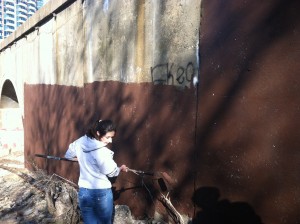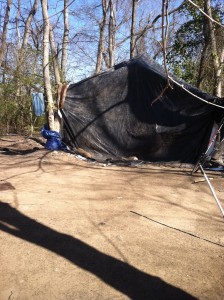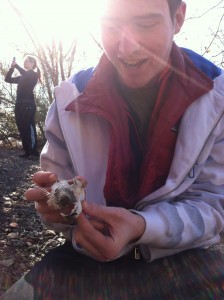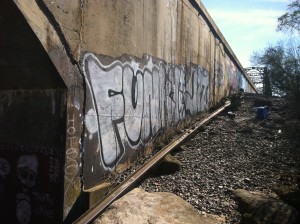This past weekend was filled with an assortment of volunteering adventures. On Friday, several of us earth lodgers got pretty rebellious. Under the direction of Ralph White, we “trespassed” and ventured, quite slowly, across the railroad next to the heron rookery, equipped with paint rollers and lots of trash bags. My group helped paint over some of the graffiti visible from the beach across the river and then went to assist the other group that was helping to clear out trash at the homeless encampment. On Saturday, a few of us headed down the William Byrd Community House. Our tasks for the day included clearing out all the Bermuda grass from a plant bed, folding tarps, and clearing out and moving a compost bin. 
A common theme seemed to pervade my observations during my time spent volunteering: contrast. The first huge contrast I noticed, as Ralph White pointed out a few weeks earlier, was the contrast between the wealthy and the poor. Standing by the homeless encampment, you can look up and see these huge, fancy high rise apartments, where some of the most well-off Richmonders live. You can then look right in front of you and see a place where, instead of sleeping in queen sized beds on cotton sheets, the inhabitants sleep in old sleeping bags, where, instead of enjoying the comfort of central heating, the inhabitants must depend the heat of their fire or the insulation from the tarps providing the structure of their tent, and where, instead of throwing their trash in a nice trashcan, the inhabitants have to toss their trash in a smelly pile outside their home and then traipse all the way across a railroad bridge every time they need to take it out.  One of the things that struck me about this contrast was that both these groups of people, while their lives are drastically different, have the opportunity to experience and appreciate the James. One of the things that has always drawn me towards nature is the fact that it doesn’t really discriminate; an earthquake will wreak havoc on everyone involved and a tree will provide shade and solace for anyone. It can also have the ability to bring people together, as evidenced in Ralph’s stories of blue collar and white collar fisherman all coming down to the river to fish during the fish migration and in his friend’s stories about how both doctors and people who are unemployed come together to enjoy the river via kayaking.
One of the things that struck me about this contrast was that both these groups of people, while their lives are drastically different, have the opportunity to experience and appreciate the James. One of the things that has always drawn me towards nature is the fact that it doesn’t really discriminate; an earthquake will wreak havoc on everyone involved and a tree will provide shade and solace for anyone. It can also have the ability to bring people together, as evidenced in Ralph’s stories of blue collar and white collar fisherman all coming down to the river to fish during the fish migration and in his friend’s stories about how both doctors and people who are unemployed come together to enjoy the river via kayaking.
 There were many other contrasts I noticed, such as the contrast between the graffiti on the bridge and what Ralph called art, and the contrast between the benefits of nitrogen for soil versus the detriments of the nutrient for water that we learned from Matt at William Byrd. Overall, volunteering this weekend was an extremely rewarding experience, with regards to both getting to observe different parts of Richmond’s society as well as spending time with my fellow earth lodgers.
There were many other contrasts I noticed, such as the contrast between the graffiti on the bridge and what Ralph called art, and the contrast between the benefits of nitrogen for soil versus the detriments of the nutrient for water that we learned from Matt at William Byrd. Overall, volunteering this weekend was an extremely rewarding experience, with regards to both getting to observe different parts of Richmond’s society as well as spending time with my fellow earth lodgers.
We also made a new friend! While we were painting over the graffiti, we found the remains of what we determined to be a raccoon and we deemed him “Conner the Coon.” May he rest in peace. 

